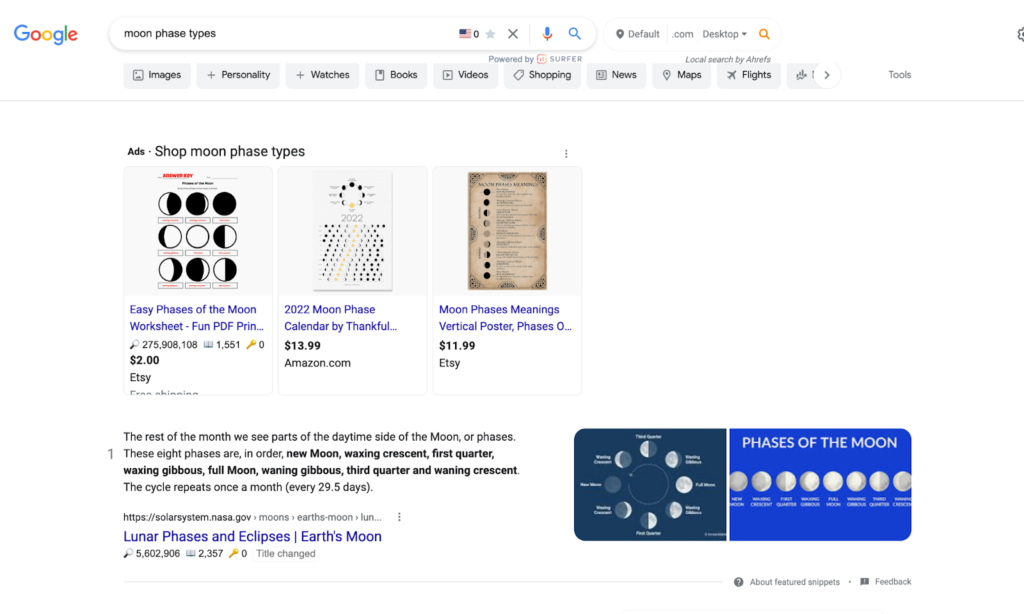Blog: Search Intent Analysis: The Ultimate Guide
Table of Contents
Search engine optimization (SEO) is about reaching your target audience by creating helpful content that addresses their queries in search engines. But being helpful isn’t enough. The content you create also has to match what search engines think the user is looking for. That’s where a search intent analysis comes in.
Countless factors make up the ranking algorithms search engines use. Search intent is one of those factors, and it’s a variable any marketer needs to know. Being able to analyze and understand it is perhaps one of the most important things you can do during your keyword research stage.
What is Search Intent?
Search intent is understanding what type of information a user is looking for when they type a given query into Google. Users type in all sorts of variations of keywords and phrases, and Google’s job is to serve them the type of content it believes answers the user’s question.
For example, if someone searches “baseball,” they could be searching for:
- The scores of tonight’s games
- A baseball to purchase
- Instructions on how to play baseball
- Tickets to watch their local team
It’s Google’s job to determine which of those the user wants. As a marketer, it’s your responsibility to create the type of content a user is searching for when they search a keyword related to your business.
With Google’s recent content helpfulness update, creating content that is original, designed for users and not search engines, and really answers the question (intent) of the search is key.
Why is Search Intent for SEO Important?
Search intent is important to Google because its algorithms are designed to give the user what they want. It earns its revenue by convincing users they can get the best results by using their search engine, and then selling ads based on the keywords.
So if Google didn’t understand search intent, it couldn’t show users the results they are looking for. Instead, someone looking to buy a wedding dress who searches “wedding dress” might be served information about the history of wedding dress designs through the decades and be unable to find a local store near them.
As the marketer writing editorial content that fits your audience, it’s your job to align the content you create for your target keywords with the type of content Google ranks for those queries.
So if you are writing a page about the history of wedding dresses, you shouldn’t model your page after what shows in the search engine results page (SERP) for “wedding dresses” but instead what it shows for “history of wedding dresses.”
Google’s algorithms predict the search intent of the user. You then create content that matches Google’s prediction.
Types of Search Intent
There are five common types of search intent for SEO, and each returns a unique SERP. Those five types are:
- Informational
- Navigational
- Transactional
- Commercial
- Hybrid
By performing a thorough search intent analysis, you’ll be able to better identify which your content is and how you should approach that content as a result. This can be done for new content, as well as existing content in need of a refresh.
Informational
Informational search intent is exactly what it sounds like — someone is searching for information about a particular topic, and Google will rank pages that provide that information in the best, most comprehensive way.
Informational searches can be identified by keywords that include common question words:
- Who
- What
- When
- Why
- How
If someone searches “why does the moon have phases,” Google returns results that are between 200-400 words directly answering the question. These pages include subtopics such as:
- The Different Phases of the Moon
- How Do We See the Moon?
- Changes in the Moon
The top results directly target the query, while the additional topics are also ones Google would expect someone to want to know if they are searching about moon phases.
So if you wanted your site to rank for the query “why does the moon have phases,” you should title your page to target that query and then write several hundred words on the topic.
You wouldn’t want to go too far off-topic, but including relevant subheaders that answer natural follow-up questions would satisfy the user’s search. Further, you should include images of each phase of the moon on the page.
If it’s clear the user is looking for information, write comprehensive content that gives them the exact information they are searching for. If the SERP shows features snippets, you can target that kind of featured snippet in your writing and schema markup.
Navigational
A navigational query indicates the user is searching for a particular website. If someone searches “Instagram,” Google assumes they want to visit the social media site, so the top results are all pages from Instagram.com or links to download the app.
Navigational queries measure a brand’s strength. If you have a high number of users searching directly for your site, it means you have a recognizable brand people are seeking out.
On the other hand, if searches for your brand are minimal, you may need to build better brand awareness, or ramp up your content to rank for non-branded terms.
If you own Mike’s Pest Control and no one in your area is searching “Mike’s Pest Control,” you either need to build brand awareness or create the type of content that will help your site rank around terms such as:
- Pest control near me
- When should you hire pest control
- What does a pest control company do
Navigational queries are especially helpful for your site because they result in a high click-through rate, meaning someone who searches “Mike’s Pest Control” has a much higher chance of clicking through to your site than someone who searches “pest control near me.”
You’ll face minimal competition for branded terms because Google knows the user wants to visit your site, so your site will often take up the top few positions.
Transactional
A transactional search indicates the user is ready to purchase something. It’s usually easy to tell if a search is transactional, because it includes a specific product name or a term such as:
- Buy X
- Purchase Y
- Z for sale
The SERP for a transactional keyword is distinct from an informational or navigational search, but it doesn’t always look the same for each transactional search.
One common feature of a transactional search is the shopping carousel ads at the top of the SERP, and a map of nearby stores that sell the item. If you search “buy action figures,” Google gives you the option to purchase action figures online, or shows you stores near you that have action figures in stock.

These searches are common for more expensive products. While someone might buy a $20 action fi
If you look at the rest of the SERP, you’ll see the pages aren’t long, informational pages about action figures but are instead store pages where someone could easily purchase an action figure online.
Even if you don’t qualify the search with “buy,” Google still assumes a transactional intent, listing a map of nearby stores and ecommerce brands, not listing Wikipedia’s page about action figures until the seventh position.
Commercial investigation
A commercial investigation is a close relative of a transactional search, but the distinction here is the searcher is likely not yet ready to purchase something. Instead, they are exploring their options across multiple sites.
These searches are common for more expensive products. While someone might buy a $20 action figure in a matter of minutes, they will spend much more time searching for the right laptop, often searching phrases such as:
- Best laptop for the money
- Best laptop brands
- Laptops that have long battery life
The SERPs for these terms are often aggregator pages, which are a mix of informational and transactional.

They are informational because they provide the searcher with detail about the products listed, but also transactional in that they allow users to quickly purchase the item, such as through an affiliate program.
Hybrid
The fifth type of intent isn’t necessarily a new one on its own, but rather a combination of the other types of intent. When Google can’t identify a clear search intent, it will show a combo page with different pages and SERP features. Ads can show up next to an informational featured snippet that’s not trying to sell you anything. TLDR, it’s important to note that if you target this query, you could be losing out on CTR from these ads.

How to Determine Search Intent
Before you create a page that’s optimized for a particular search intent, you need to know how to identify each type. We touched on a few tips while discussing each, but this section will cover in detail how you can know your content is targeting the right intent through a search intent analysis.
A word of warning: many SEO tools these days claim to be able to determine search intent through their own algorithms. While these tools can be helpful in getting an overview, it’s important to go in and double-check the intent for yourself as these tools are sometimes faulty and inaccurate.
Clues in Keywords
When performing a search intent analysis, your first hint at intent is found in the keyword itself. Often, you can identify what exactly the searcher is looking for through a common sense analysis of the term itself.
For example, searches that ask a question, such as “How to fix a broken garbage disposal,” are looking for information.
While you don’t yet know whether Google sees words, images, video, or a combination of those, as the best answer, you do know your page shouldn’t be primarily about selling garbage disposal parts or ranking the top 10 best brands for garbage disposal parts.
Navigational searches are easy to identify because they are brand names. Any time a search includes only a brand name, you can infer the searcher wants to visit a property, whether the website, social media pages, or physical stores of that brand.

On the other hand, if the brand name has other terms around it, such as “Facebook’s annual revenue,” you wouldn’t expect to see results from Facebook.com. Instead, you’d expect to see other sites writing about Facebook’s annual revenue.
Transactional searches are easy to identify if the word “buy” appears in the search, but there are other ways someone can make a transactional search. If the search is just the name of a product, such as “coffee maker,” you can expect a transactional SERP filled with shopping ads and ecommerce sites.

Commercial investigation searches are most obvious when the search includes “best [x]” or qualifies the item with a phrase such as “for men” or “on a budget.”
If someone searches “best shoes,” “shoes for men,” or “shoes on a budget,” it indicates they are doing research on that product as part of the buying process.
Search Intent Analysis on the SERP
After your initial thoughts on search intent based on the keyword, you can test your theory by Googling the keyword and analyzing the SERP. The type of SERP and its features are the best indicators of what Google is viewing as the search intent for SEO.
For example, if you search “how many hours of sleep should a dog get,” the SERP is purely informational — it answers the question with a featured snippet at the top, followed by all organic listings below that are pages answering that question.

Notice there is no map, because Google doesn’t think the user needs to go anywhere, and there are no ecommerce stores selling dog beds. It’s clear Google sees the intent as informational.
To continue with our canine example, a search for “chewy” brings up results related to the pet supply store Chewy.com, including its Twitter, Facebook, Instagram, Pinterest, and Wikipedia.
Even though the word “chewy” could be referring to the texture of food, Google sees the intent as someone searching for a pet supply store, so the results are all its online properties.
Modifying our search to “chewy dog beds” changes our SERP to a transactional one, with ads at the top, and Chewy’s product pages as the top organic listings.

To change our search to commercial investigation, we can search “best dog beds.” The SERP has shopping ads at the top, followed by sites ranking the best dog beds. Many of these sites are affiliate sites, so the user can quickly go from commercial investigation to transactional.
Partner with Silverback Strategies to Reach Your Audience Online
Performing search intent analysis is a vital first step as Google’s algorithms are designed to show different content based on what it thinks the user is searching for, and you need to create content that aligns with the SERP in order to rank your page.
At Silverback Strategies, we’re experts in identifying the right opportunities to reach your audience and at crafting content that earns your site a place at the top of Google search results.
Our Editorial SEO services are all about ensuring your site has the technical foundation to be found by search engines and then creating content that reaches your audience. Contact us today to learn about growth opportunities for your business.


